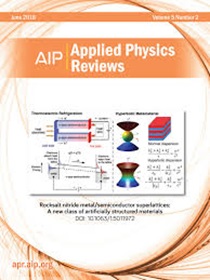On the design space between molecular mechanics and machine learning force fields
IF 11.9
1区 物理与天体物理
Q1 PHYSICS, APPLIED
引用次数: 0
Abstract
A force field as accurate as quantum mechanics (QMs) and as fast as molecular mechanics (MMs), with which one can simulate a biomolecular system efficiently enough and meaningfully enough to get quantitative insights, is among the most ardent dreams of biophysicists—a dream, nevertheless, not to be fulfilled any time soon. Machine learning force fields (MLFFs) represent a meaningful endeavor in this direction, where differentiable neural functions are parametrized to fit ab initio energies and forces through automatic differentiation. We argue that, as of now, the utility of the MLFF models is no longer bottlenecked by accuracy but primarily by their speed, as well as stability and generalizability—many recent variants, on limited chemical spaces, have long surpassed the chemical accuracy of 1 kcal/mol—the empirical threshold beyond which realistic chemical predictions are possible—though still magnitudes slower than MM. Hoping to kindle exploration and design of faster, albeit perhaps slightly less accurate MLFFs, in this review, we focus our attention on the technical design space (the speed-accuracy trade-off) between MM and ML force fields. After a brief review of the building blocks (from a machine learning-centric point of view) of force fields of either kind, we discuss the desired properties and challenges now faced by the force field development community, survey the efforts to make MM force fields more accurate and ML force fields faster, and envision what the next generation of MLFF might look like.分子力学与机器学习力场之间的设计空间
一个像量子力学(QMs)一样精确、像分子力学(MMs)一样快速的力场,可以让人们足够高效、足够有意义地模拟生物分子系统,从而获得定量的洞察力,这是生物物理学家最热切的梦想之一--然而,这个梦想不会很快实现。机器学习力场(MLFFs)代表了这一方向上有意义的努力,通过自动微分将可微分神经函数参数化,以适应原子能量和力。我们认为,到目前为止,MLFF 模型的实用性不再受限于准确性,而主要受限于其速度、稳定性和普适性--在有限的化学空间上,许多最新的变体早已超过了 1 kcal/mol 的化学准确性--超过这一经验阈值,现实的化学预测才有可能--尽管速度仍然比 MM 慢很多。在本综述中,我们将注意力集中在 MM 力场和 ML 力场之间的技术设计空间(速度-精度权衡)上,希望能激发对更快、但精度可能略低的 ML 力场的探索和设计。在简要回顾了这两种力场的构件(从机器学习的角度来看)之后,我们讨论了力场开发界所期望的特性和目前面临的挑战,调查了为使 MM 力场更精确、ML 力场更快速所做的努力,并设想了下一代 MLFF 的样子。
本文章由计算机程序翻译,如有差异,请以英文原文为准。
求助全文
约1分钟内获得全文
求助全文
来源期刊

Applied physics reviews
PHYSICS, APPLIED-
CiteScore
22.50
自引率
2.00%
发文量
113
审稿时长
2 months
期刊介绍:
Applied Physics Reviews (APR) is a journal featuring articles on critical topics in experimental or theoretical research in applied physics and applications of physics to other scientific and engineering branches. The publication includes two main types of articles:
Original Research: These articles report on high-quality, novel research studies that are of significant interest to the applied physics community.
Reviews: Review articles in APR can either be authoritative and comprehensive assessments of established areas of applied physics or short, timely reviews of recent advances in established fields or emerging areas of applied physics.
 求助内容:
求助内容: 应助结果提醒方式:
应助结果提醒方式:


